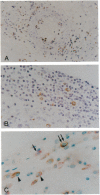Abstract
The early response gene for monocyte chemoattractant protein 1 (MCP-1) encodes a potent chemotactic factor that is specific for monocytes. To determine whether MCP-1 is involved in macrophage recruitment in cardiac allografts, we studied time-dependent MCP-1 gene and protein expression patterns in the heterotopic, Lewis to F-344 rat transplantation model (by reverse transcription-PCR and immunohistochemistry). There was a significant increase (8- to 12-fold) in MCP-1 gene transcripts in cardiac allografts compared with host hearts at 7, 14, and 28 days after transplantation. This induction was not observed with syngeneic transplants or hosts exposed to the same circulating cells and blood products. The MCP-1 gene product was expressed predominantly by mononuclear cells that double-stained with antimacrophage antibody (ED1) and localized to the interstitial and vascular spaces of the allografts. Immunocytochemical cell counting revealed significant increases in both MCP-1- and ED1-immunopositive cells in 7-, 14-, and 28-day allografts (in comparison with day 0 hearts). The absolute number of MCP-1-positive cells (5-7%) was lower than that of ED1-positive cells (25-34%) at all time points, suggesting that MCP-1-positive cells represent a subpopulation of activated macrophages. The persistent expression of MCP-1 in association with increased macrophage localization suggests that this inducible mediator contributes to the chronic inflammatory response following cardiac transplantation and that it may play a role in the pathogenesis of transplant arteriosclerosis.
Full text
PDF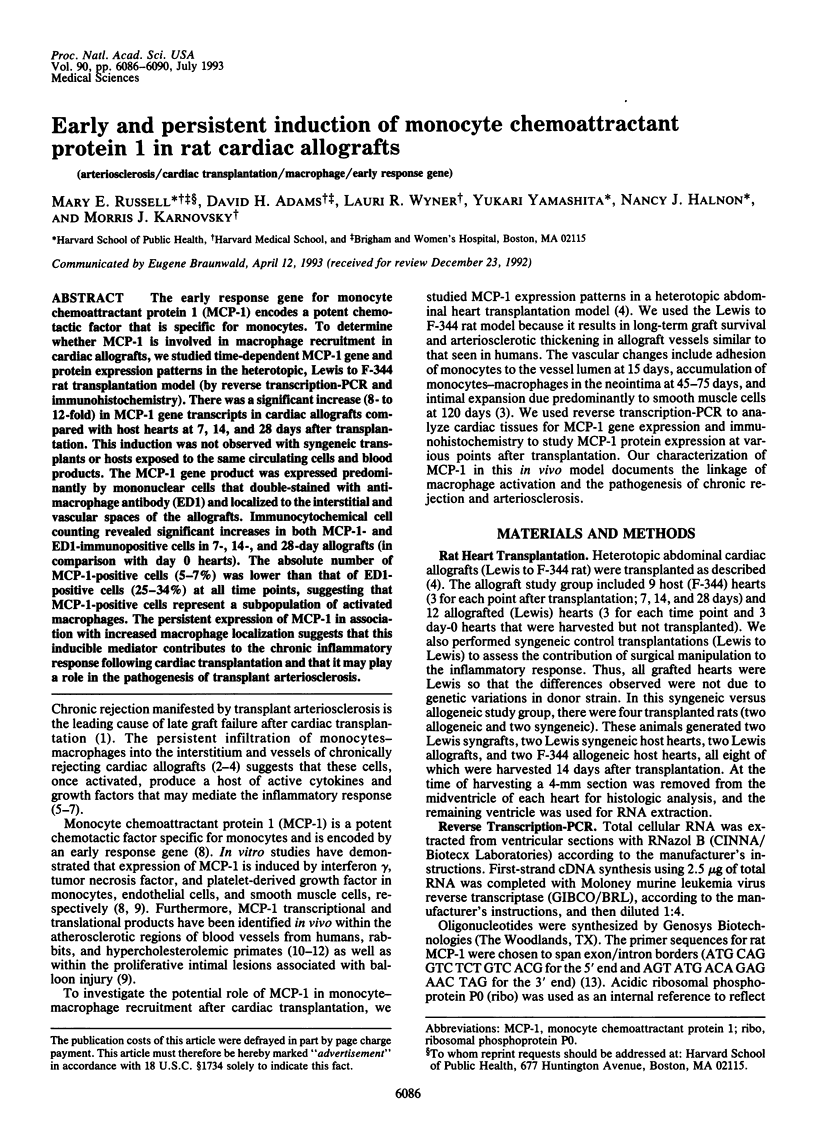
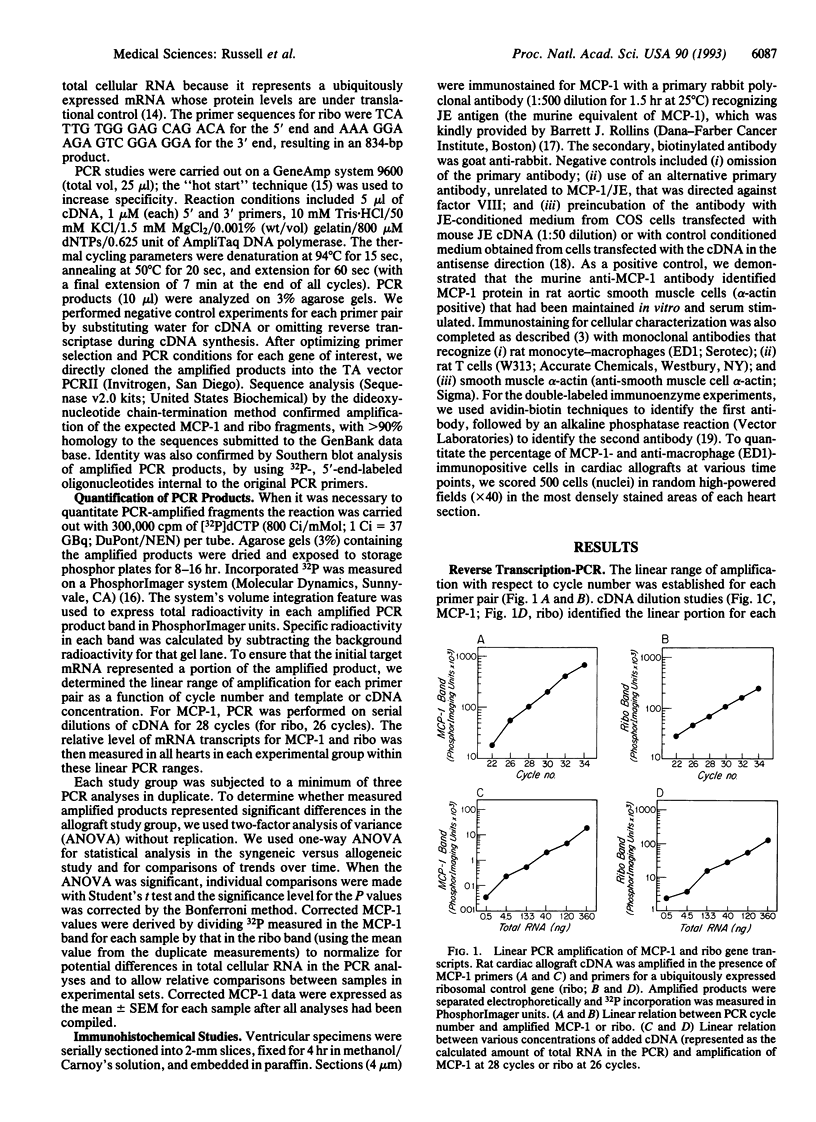
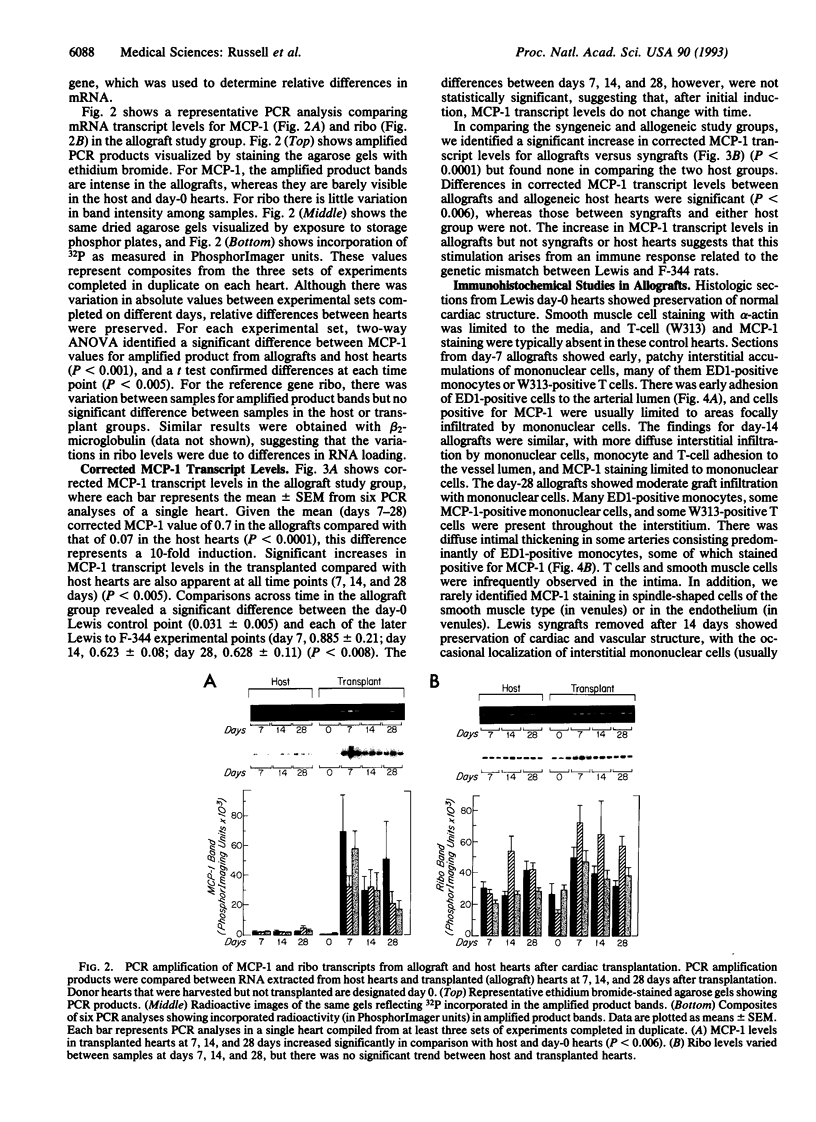
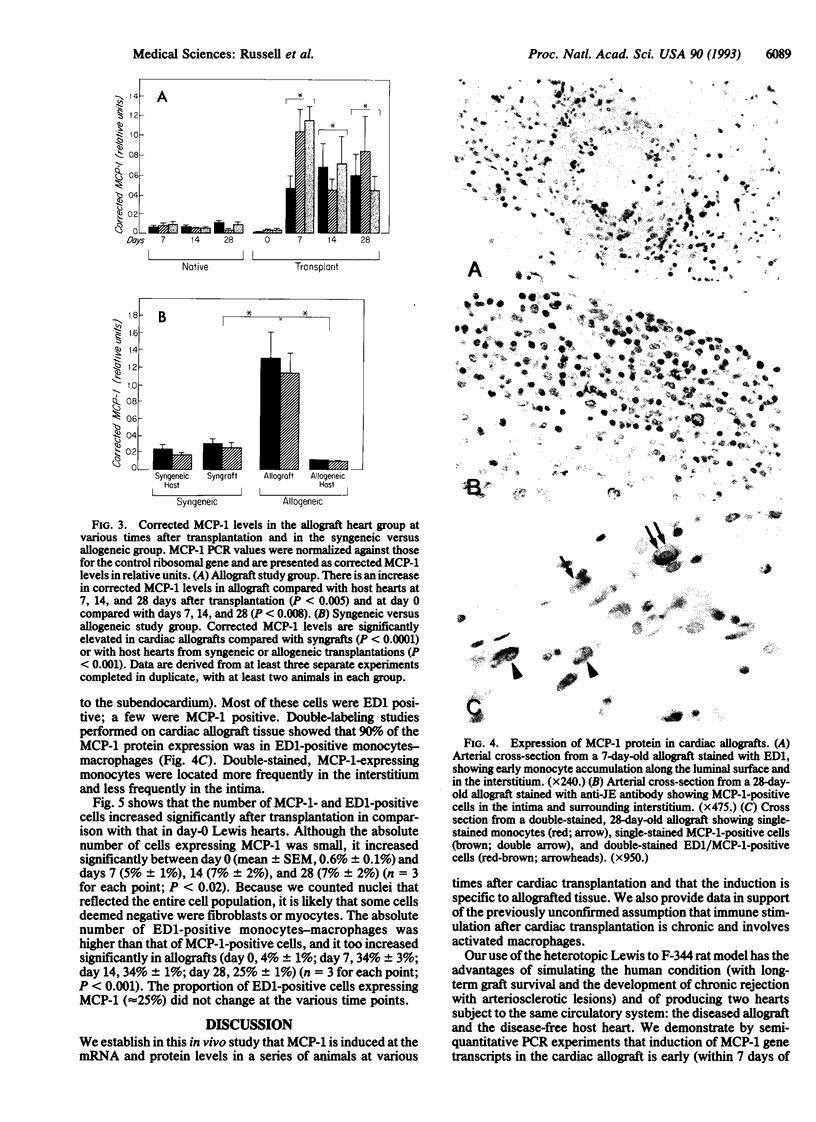
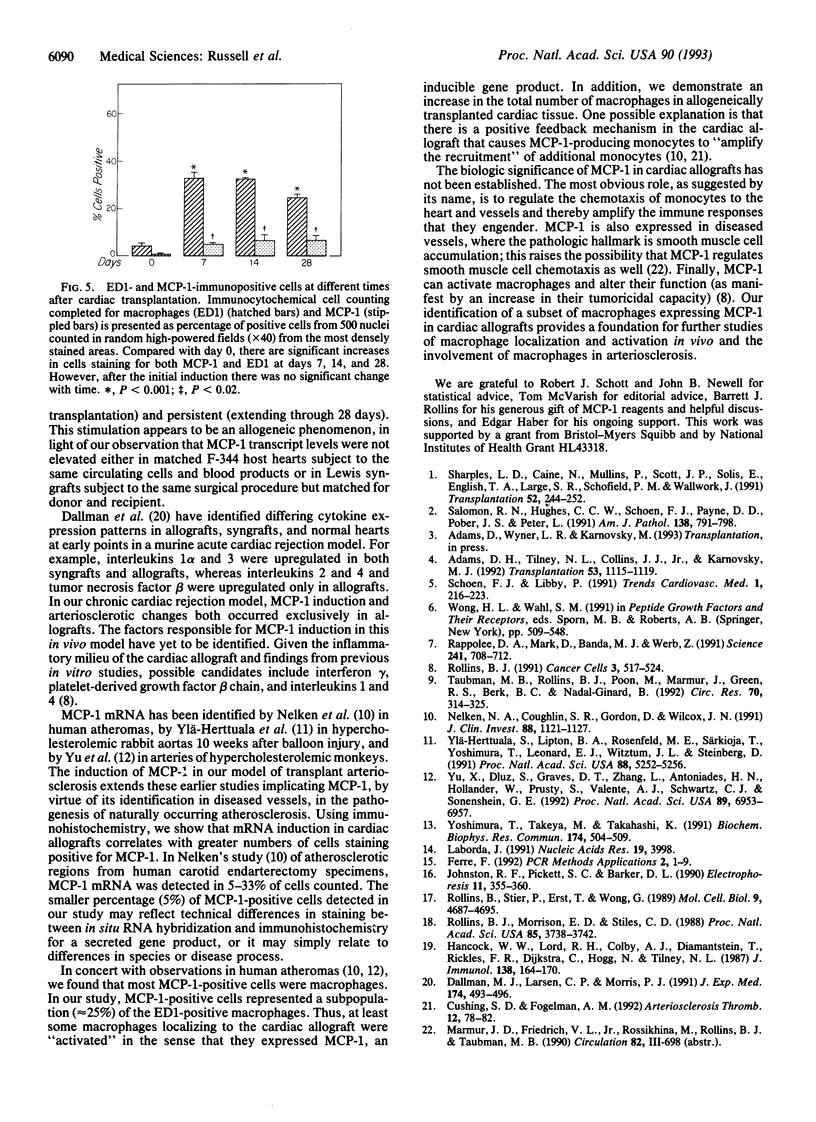
Images in this article
Selected References
These references are in PubMed. This may not be the complete list of references from this article.
- Adams D. H., Tilney N. L., Collins J. J., Jr, Karnovsky M. J. Experimental graft arteriosclerosis. I. The Lewis-to-F-344 allograft model. Transplantation. 1992 May;53(5):1115–1119. [PubMed] [Google Scholar]
- Cushing S. D., Fogelman A. M. Monocytes may amplify their recruitment into inflammatory lesions by inducing monocyte chemotactic protein. Arterioscler Thromb. 1992 Jan;12(1):78–82. doi: 10.1161/01.atv.12.1.78. [DOI] [PubMed] [Google Scholar]
- Dallman M. J., Larsen C. P., Morris P. J. Cytokine gene transcription in vascularised organ grafts: analysis using semiquantitative polymerase chain reaction. J Exp Med. 1991 Aug 1;174(2):493–496. doi: 10.1084/jem.174.2.493. [DOI] [PMC free article] [PubMed] [Google Scholar]
- Ferre F. Quantitative or semi-quantitative PCR: reality versus myth. PCR Methods Appl. 1992 Aug;2(1):1–9. doi: 10.1101/gr.2.1.1. [DOI] [PubMed] [Google Scholar]
- Hancock W. W., Lord R. H., Colby A. J., Diamantstein T., Rickles F. R., Dijkstra C., Hogg N., Tilney N. L. Identification of IL 2R+ T cells and macrophages within rejecting rat cardiac allografts, and comparison of the effects of treatment with anti-IL 2R monoclonal antibody or cyclosporin. J Immunol. 1987 Jan 1;138(1):164–170. [PubMed] [Google Scholar]
- Johnston R. F., Pickett S. C., Barker D. L. Autoradiography using storage phosphor technology. Electrophoresis. 1990 May;11(5):355–360. doi: 10.1002/elps.1150110503. [DOI] [PubMed] [Google Scholar]
- Laborda J. 36B4 cDNA used as an estradiol-independent mRNA control is the cDNA for human acidic ribosomal phosphoprotein PO. Nucleic Acids Res. 1991 Jul 25;19(14):3998–3998. doi: 10.1093/nar/19.14.3998. [DOI] [PMC free article] [PubMed] [Google Scholar]
- Nelken N. A., Coughlin S. R., Gordon D., Wilcox J. N. Monocyte chemoattractant protein-1 in human atheromatous plaques. J Clin Invest. 1991 Oct;88(4):1121–1127. doi: 10.1172/JCI115411. [DOI] [PMC free article] [PubMed] [Google Scholar]
- Rappolee D. A., Mark D., Banda M. J., Werb Z. Wound macrophages express TGF-alpha and other growth factors in vivo: analysis by mRNA phenotyping. Science. 1988 Aug 5;241(4866):708–712. doi: 10.1126/science.3041594. [DOI] [PubMed] [Google Scholar]
- Rollins B. J. JE/MCP-1: an early-response gene encodes a monocyte-specific cytokine. Cancer Cells. 1991 Dec;3(12):517–524. [PubMed] [Google Scholar]
- Rollins B. J., Morrison E. D., Stiles C. D. Cloning and expression of JE, a gene inducible by platelet-derived growth factor and whose product has cytokine-like properties. Proc Natl Acad Sci U S A. 1988 Jun;85(11):3738–3742. doi: 10.1073/pnas.85.11.3738. [DOI] [PMC free article] [PubMed] [Google Scholar]
- Rollins B. J., Stier P., Ernst T., Wong G. G. The human homolog of the JE gene encodes a monocyte secretory protein. Mol Cell Biol. 1989 Nov;9(11):4687–4695. doi: 10.1128/mcb.9.11.4687. [DOI] [PMC free article] [PubMed] [Google Scholar]
- Salomon R. N., Hughes C. C., Schoen F. J., Payne D. D., Pober J. S., Libby P. Human coronary transplantation-associated arteriosclerosis. Evidence for a chronic immune reaction to activated graft endothelial cells. Am J Pathol. 1991 Apr;138(4):791–798. [PMC free article] [PubMed] [Google Scholar]
- Sharples L. D., Caine N., Mullins P., Scott J. P., Solis E., English T. A., Large S. R., Schofield P. M., Wallwork J. Risk factor analysis for the major hazards following heart transplantation--rejection, infection, and coronary occlusive disease. Transplantation. 1991 Aug;52(2):244–252. doi: 10.1097/00007890-199108000-00012. [DOI] [PubMed] [Google Scholar]
- Taubman M. B., Rollins B. J., Poon M., Marmur J., Green R. S., Berk B. C., Nadal-Ginard B. JE mRNA accumulates rapidly in aortic injury and in platelet-derived growth factor-stimulated vascular smooth muscle cells. Circ Res. 1992 Feb;70(2):314–325. doi: 10.1161/01.res.70.2.314. [DOI] [PubMed] [Google Scholar]
- Ylä-Herttuala S., Lipton B. A., Rosenfeld M. E., Särkioja T., Yoshimura T., Leonard E. J., Witztum J. L., Steinberg D. Expression of monocyte chemoattractant protein 1 in macrophage-rich areas of human and rabbit atherosclerotic lesions. Proc Natl Acad Sci U S A. 1991 Jun 15;88(12):5252–5256. doi: 10.1073/pnas.88.12.5252. [DOI] [PMC free article] [PubMed] [Google Scholar]
- Yoshimura T., Takeya M., Takahashi K. Molecular cloning of rat monocyte chemoattractant protein-1 (MCP-1) and its expression in rat spleen cells and tumor cell lines. Biochem Biophys Res Commun. 1991 Jan 31;174(2):504–509. doi: 10.1016/0006-291x(91)91445-i. [DOI] [PubMed] [Google Scholar]
- Yu X., Dluz S., Graves D. T., Zhang L., Antoniades H. N., Hollander W., Prusty S., Valente A. J., Schwartz C. J., Sonenshein G. E. Elevated expression of monocyte chemoattractant protein 1 by vascular smooth muscle cells in hypercholesterolemic primates. Proc Natl Acad Sci U S A. 1992 Aug 1;89(15):6953–6957. doi: 10.1073/pnas.89.15.6953. [DOI] [PMC free article] [PubMed] [Google Scholar]




